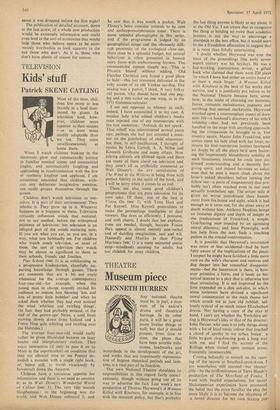TELEVISION
Kids' stuff
Patrick SKENE CATLING
Most of the time, chil- dren live more or less bravely in a land dom- inated by giants. In television land, how- ever, children seem superior to their seniors —or at least more readily adaptable than we are. They seem unselfcansciously at home there.
When I watch children basking in the electronic glow and automatically joining in familiar musical scenes and commercial jingles, and automatically laughing and applauding in synchronisation with the live or synthetic laughter and applause, I am sometimes reminded that children, with- out any deliberate imaginative exertion, can easily project themselves through the screen.
Children don't watch television as out- siders. It is part of their environment They inhabit it. They grow up in it. Whatever happens in it happens to them. Television certainly influences minds that matured, not to say ossified, before the widespread existence of television; but television is an integral part of the minds maturing now. If you are what you eat, so you are, in 'a way, what you habitually see. For children who watch much television, or most of them, the sort of television they watch may be almost as significant to them as their schools, friends and families.
Play School (Bac l) is as exhilarating as a progressive kindergarten, cheerfully im- parting knowledge through games. There are moments that are a bit too coyly whimsical for the average contemporary four-year-old—for example, when the young man in charge recently invited his audience to imitate him blowing 'lots and lots of pretty little bubbles' and when he asked them whether they had ever noticed the wind 'whirling and twirling things'. (In fact, they had probably noticed, at the end of the grown-ups' News, a cold front moving slowly down from Iceland and a Force Nine gale whirling and twirling over the Hebrides.) The average four-year-old would really rather be given illustrated lectures on laser beams and interplanetary rockets. They enjoy instruction (if only to pass it on to Mum in the supermarket) on condition that they are allowed time to see Popeye de- molish a monster with a single right hook, or, better still, to travel vicariously by hovercraft down the Amazon.
Children have a voracious appetite for information and there is no need to sweeten it, as in Walt Disney's Wonderful World of Colour (anc 1). The very title sounds blasphemous: in the beginning was the world, and Walt Disney coloured it, and he saw that it was worth a packet. Walt Disney's heirs consider animals to be cute and anthropomorphisation cuter. There is some splendid photography in this series, and if the programme is judged by its geographical range and the obviously diffi- cult proximity of the zoological close-ups, there must be a splendid budget, but animal behaviour is often presented in human story form with embarrassing feyness. The commentator cannot simply ray, 'This is Pitcairn Island' without adding, 'Old Fletcher Christian sure found a good place to hide'—this last comment delivered in the salty accent of an old Yankee sea-dog. The seadog was a parrot, I think. A very folksy old parrot, who should have had one peg- leg and a tiny sailor on one wing, as in the 1971 Guinness calendar.
I am not opposed to whimsy as such; indeed, I have committed it to my cost. A maiden lady who edited children's books once rejected one of my manuscripts with the tart anotation: 'Animals do not speak'. That rebuff was administered several years ago; perhaps she had just attended a semi- nar on the psychology of child education; but then, in self-justification, I thought of stories by Lewis Carroll, A. A. Milne and Kenneth Grahame and many others. Now talking animals are alldwed again and there are many of them about on television and they aren't all as artificially mannered as Walt Disney's: the ATV serialisation of The Wind in the Willows is being done with perfect fidelity to the spirit of the book, and I will be sorry when it comes to an end.
There are also some good children's programmes that are pure television for its own sake. Of these, one of the best is Vision On (BBC 1), with Tony Hart and Pat Keysell. Miss Keysell gesticulates to make the proceedings intelligible to deaf viewers. She does so efficiently, I presume, and with charm. I doubt that her explana- tions are needed, though, because Vision On's appeal is almost entirely non-verbal and of dazzling imagination, zest and wit. Dastardly and Manley in their Flying Machines (nwl) is a mere animated comic strip—mindlessly amusing for adults, but too childish for most children.






































 Previous page
Previous page